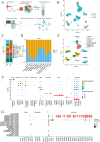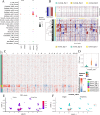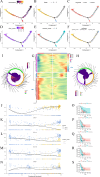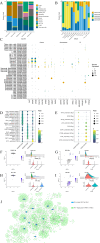Single-cell RNA sequencing highlights the unique tumor microenvironment of small cell neuroendocrine cervical carcinoma
- PMID: 39762893
- PMCID: PMC11702138
- DOI: 10.1186/s12967-024-05977-z
Single-cell RNA sequencing highlights the unique tumor microenvironment of small cell neuroendocrine cervical carcinoma
Abstract
Small cell neuroendocrine cervical carcinoma is a highly aggressive tumor characterized by early metastasis, a high recurrence rate, and poor prognosis. This study represents the first instance of single-cell sequencing conducted on small cell neuroendocrine carcinoma of the cervix worldwide. Analysis of gene expression regulatory networks revealed that the transcription factor TFF3 drived up-regulation of ELF3. Furthermore, our findings indicated that the neuroendocrine marker genes and gene regulatory networks associated with small cell neuroendocrine cervical carcinoma differed from those observed in lung, small intestine, and liver neuroendocrine carcinoma within the GEO database, suggesting tissue-specific origins for these malignancies. Overall, this study addresses a significant research in understanding small cell neuroendocrine cervical carcinoma in vivo and provides valuable insights for guiding radiotherapy, chemotherapy, and targeted therapy.
Keywords: Cervical cancer; Neuroendocrine; Single-nucleus RNA sequencing; Tumor microenvironment.
© 2024. The Author(s).
Conflict of interest statement
Declarations. Ethics approval and consent to participate: The study was conducted in accordance with the Declaration of Helsinki, and approved by the Ethics Committee of Obstetrics and Gynecology Hospital of Fudan University(2024-113). Informed consent was obtained from all subjects involved in the study. Written informed consent has been obtained from the patient to publish this paper. Consent for publication: Not applicable. Competing interests: The authors declare no conflicts of interest.
Figures








Similar articles
-
Single-Cell RNA Sequencing Reveals the Cellular Origin and Evolution of Small-Cell Neuroendocrine Carcinoma of the Cervix.J Med Virol. 2025 Jan;97(1):e70183. doi: 10.1002/jmv.70183. J Med Virol. 2025. PMID: 39831355
-
Single-cell RNA sequencing reveals tumor heterogeneity in small cell neuroendocrine cervical carcinoma.Commun Biol. 2025 Feb 5;8(1):184. doi: 10.1038/s42003-025-07605-y. Commun Biol. 2025. PMID: 39910262 Free PMC article.
-
Single-Cell Transcriptome Sequencing and Analysis Provide a New Approach for the Treatment of Small Cell Neuroendocrine Carcinoma of the Cervix.Neuroendocrinology. 2025;115(1):13-33. doi: 10.1159/000542833. Epub 2024 Nov 27. Neuroendocrinology. 2025. PMID: 39602898
-
[Neuroendocrine carcinoma of the cervix: a case report and review of the literature].Pan Afr Med J. 2017 Jun 2;27:82. doi: 10.11604/pamj.2017.27.82.10902. eCollection 2017. Pan Afr Med J. 2017. PMID: 28819503 Free PMC article. Review. French.
-
[Small cell neuroendocrine carcinoma of the uterine cervix: Report of six cases and a review of the literature].Cancer Radiother. 2014 Jun;18(3):201-7. doi: 10.1016/j.canrad.2014.01.003. Epub 2014 Mar 19. Cancer Radiother. 2014. PMID: 24656987 Review. French.
Cited by
-
Prognostic value of inflammatory markers and different treatment regimens in neuroendocrine cervical carcinoma: a retrospective study.Front Pharmacol. 2025 Aug 1;16:1652092. doi: 10.3389/fphar.2025.1652092. eCollection 2025. Front Pharmacol. 2025. PMID: 40822489 Free PMC article.
-
Comprehensive Single-Cell RNA Sequencing Analysis of Cervical Cancer: Insights Into Tumor Microenvironment and Gene Expression Dynamics.Int J Genomics. 2025 May 13;2025:5027347. doi: 10.1155/ijog/5027347. eCollection 2025. Int J Genomics. 2025. PMID: 40395456 Free PMC article.
References
-
- Society of Neuroendocrine Neoplasm of China Anti-Cancer Association. China Anti-Cancer Association guideline for diagnosis and treatment of neuroendocrine neoplasm (2022 edition). China Oncol. 2022;32(6):545–79.
-
- Saraei P, Heshmati A, Hosseini S. Small-cell neuroendocrine carcinoma of the female genital tract: a comprehensive overview. J Neuroendocrinol. 2024;36(6): e13394. - PubMed
-
- Lyu YH, Liu HX, Han X, et al. Clinicopathologic characteristics and prognostic factors of patients with surgically treated high-grade neuroendocrine carcinoma of the cervix: a multicenter retrospective study. Int J Gynaecol Obstet. 2024. - PubMed
MeSH terms
Grants and funding
- (General Program/National Natural Science Foundation of China
- 82273233); Natural Science Foundation of Shanghai (22ZR1408900); National Natural Science Foundation of China (General Program/National Natural Science Foundation of China
- 81772777); Clinical Research Plan of SHDC (No. SHDC2020CR4079); Shanghai "Rising Stars of Medical Talent" Youth Development Program-Outstanding Youth Medical Talents (SHWJRS2021-99)/National Natural Science Foundation of China
- Shanghai Science/National Natural Science Foundation of China
- technology committee medical guidance program (18411963700)./National Natural Science Foundation of China

